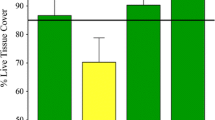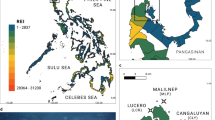Abstract
A primary objective of coral restoration is to foster the development of large, sexually reproductive colonies to reseed degraded reefs. Practitioners of Acropora cervicornis restoration favor outplanting large individuals spaced more than 50 cm apart; however, this contrasts with this species’ tendency to form high-density thickets with multiple colonies and genotypes in close proximity. Furthermore, large outplants are difficult to grow and transport, limiting scalability. We outplanted dense clusters containing multiple small, monoclonal fragments spaced 1–2 cm apart and compared their performance with that of large fragments of the same genotype planted individually. We further investigated the effect of clonal diversity by combining multiple genotypes within clusters. Dense clusters had equivalent growth and higher survivorship than large individuals and were not hindered by genotypic diversity. Our findings support outplanting dense, polyclonal clusters as a method to cultivate large, resilient A. cervicornis colonies.


Similar content being viewed by others
Data availability
The datasets generated and/or analyzed during the current study are available from the corresponding author upon reasonable request.
References
Carne L, Kaufman L, Scavo K (2016) Measuring success for Caribbean acroporid restoration: key results from ten years of work in southern Belize. Proc 13th Int Coral Reef Symp 342–368
Drury C, Greer JB, Baums I, Gintert B, Lirman D (2019) Clonal diversity impacts coral cover in Acropora cervicornis thickets: Potential relationships between density, growth, and polymorphisms. Ecol Evol 9:4518–4531. https://doi.org/10.1002/ece3.5035
Forsman ZH, Page CA, Toonen RJ, Vaughan D (2015) Growing coral larger and faster: micro-colony-fusion as a strategy for accelerating coral cover. PeerJ 3:e1313. https://doi.org/10.7717/peerj.1313
Goergen EA, Gilliam DS (2018) Outplanting technique, host genotype, and site affect the initial success of outplanted Acropora cervicornis. PeerJ 6:e4433. https://doi.org/10.7717/peerj.4433
Griffin JN, Schrack EC, Lewis K, Baums IB, Soomdat N, Silliman BR (2015) Density-dependent effects on initial growth of a branching coral under restoration. Restor Ecol 23:197–200. https://doi.org/10.1111/rec.12173
Huffmyer AS, Drury C, Majerová E, Lemus JD, Gates RD (2021) Tissue fusion and enhanced genotypic diversity support the survival of Pocillopora acuta coral recruits under thermal stress. Coral Reefs 40:447–458. https://doi.org/10.1007/s00338-021-02074-1
Huntington BE, Miller MW (2014) Location-specific metrics for rapidly estimating the abundance and condition of the threatened coral Acropora cervicornis: estimating staghorn coral abundance and condition. Restor Ecol 22:299–303. https://doi.org/10.1111/rec.12057
Johnson M, Lustic C, Bartels E, Baums IB, Gilliam DS (2011) Caribbean Acropora Restoration Guide: Best Practices for Propagation and Population Enhancement. The Nature Conservancy
Johnston L, Miller MW (2014) Negative indirect effects of neighbors on imperiled scleractinian corals. Coral Reefs 33:1047–1056. https://doi.org/10.1007/s00338-014-1176-8
Kaufman M, D’Alessandro M, Langdon C, Lirman D (2021) Influences of genotype, phenotypes, and size characteristics on lesion recovery in Caribbean staghorn coral. Mar Ecol Prog Ser 679:213–218. https://doi.org/10.3354/meps13908
Ladd MC, Shantz AA, Nedimyer K, Burkepile DE (2016) Density dependence drives habitat production and survivorship of Acropora cervicornis used for restoration on a Caribbean coral reef. Front Mar Sci 3:261. https://doi.org/10.3389/fmars.2016.00261
Lirman D, Schopmeyer S, Galvan V, Drury C, Baker AC, Baums IB (2014) Growth dynamics of the threatened Caribbean staghorn coral Acropora cervicornis: influence of host genotype, symbiont identity, colony size, and environmental setting. PLoS ONE 9:e107253. https://doi.org/10.1371/journal.pone.0107253
Neigel JE, Avise JC (1983) Clonal diversity and population structure in a reef-building coral, Acropora cervicornis: self-recognition analysis and demographic interpretation. Evolution 37:437–453. https://doi.org/10.1111/j.1558-5646.1983.tb05561.x
Rinkevich B, Loya Y (1985) Intraspecific competition in a reef coral: effects on growth and reproduction. Oecologia 66:100–105. https://doi.org/10.1007/BF00571193
Shaver EC, Silliman BR (2017) Time to cash in on positive interactions for coral restoration. PeerJ 5:e3499. https://doi.org/10.7717/peerj.3499
Shefy D, Shashar N, Rinkevich B (2020) Exploring traits of engineered coral entities to be employed in reef restoration. J Mar Sci Eng 8:1038. https://doi.org/10.3390/jmse8121038
Souter D, Planes S, Wicquart J, Logan M, Obura D, Staub F (2021) Status of Coral Reefs of the World: 2020. International Coral Reef Initiative
Tunnicliffe V (1981) Breakage and propagation of the stony coral Acropora cervicornis. Proc Natl Acad Sci 78:2427–2431. https://doi.org/10.1073/pnas.78.4.2427
Unsworth JD, Hesley D, D’Alessandro M, Lirman D (2021) Outplanting optimized: developing a more efficient coral attachment technique using Portland cement. Restor Ecol 29:e13299. https://doi.org/10.1111/rec.13299
Vargas-Ángel B, Thomas JD, Hoke SM (2003) High-latitude Acropora cervicornis thickets off Fort Lauderdale, Florida, USA. Coral Reefs 22:465–473. https://doi.org/10.1007/s00338-003-0336-z
Ware M, Garfield EN, Nedimyer K, Levy J, Kaufman L, Precht W, Winters RS, Miller SL (2020) Survivorship and growth in staghorn coral (Acropora cervicornis) outplanting projects in the Florida Keys National Marine Sanctuary. PLoS ONE 15:e0231817. https://doi.org/10.1371/journal.pone.0231817
van Woesik R, Banister RB, Bartels E, Gilliam DS, Goergen EA, Lustic C, Maxwell K, Moura A, Muller EM, Schopmeyer S, Winters RS, Lirman D (2021) Differential survival of nursery‐reared Acropora cervicornis outplants along the Florida reef tract. Restor Ecol 29:e13302. https://doi.org/10.1111/rec.13302
Acknowledgements
The authors thank A. Baker, P. Kiel, D. Gilliam, and E. Esplandiu for their contributions. This research was funded by Mote Marine Lab’s Protect Our Reefs program, NOAA’s Restoration Center (award OAA-NMFS-HCPO-2016-2004840), and the National Fish and Wildlife Foundation. The views and conclusions of this document are those of the authors and should not be interpreted as representing the opinions or policies of the US Government or the National Fish and Wildlife Foundation and its funding sources.
Author information
Authors and Affiliations
Contributions
JU, DH, and DL contributed to the study conception and design. All authors contributed to the experiment setup and monitoring. Data analysis and visualization were conducted by JU. The first draft of the manuscript was written by JU, and all authors commented on previous versions of the manuscript. All authors read and approved the final manuscript.
Corresponding author
Ethics declarations
Ethical standards
All corals were collected, propagated, and outplanted under a Florida Fish and Wildlife Conservation Commission Special Activity License (SAL-19-1794-SCRP).
Conflict of interest
On behalf of all authors, the corresponding author states that there is no conflict of interest.
Additional information
Publisher's Note
Springer Nature remains neutral with regard to jurisdictional claims in published maps and institutional affiliations.
Rights and permissions
Springer Nature or its licensor (e.g. a society or other partner) holds exclusive rights to this article under a publishing agreement with the author(s) or other rightsholder(s); author self-archiving of the accepted manuscript version of this article is solely governed by the terms of such publishing agreement and applicable law.
About this article
Cite this article
Unsworth, J.D., Hesley, D., D’Alessandro, M. et al. Dense clusters improve efficiency and foster colony development in restored Acropora cervicornis. Coral Reefs 42, 337–341 (2023). https://doi.org/10.1007/s00338-022-02342-8
Received:
Accepted:
Published:
Issue Date:
DOI: https://doi.org/10.1007/s00338-022-02342-8




